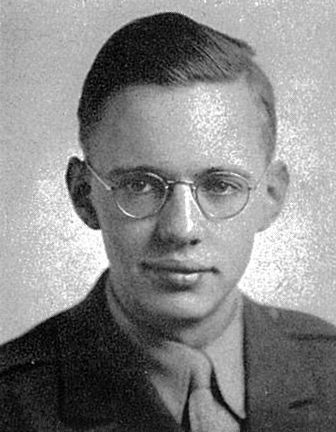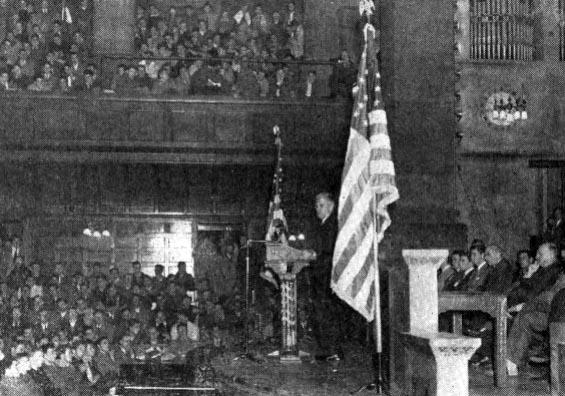On Sunday, Dec. 7, 1941, shock and outrage were the dominant reactions on the Princeton campus. News of the Japanese attack on Pearl Harbor was a “game changer,” more for some than for others of us. World War I and the policies of Britain and France had fueled strong isolationist feeling in the United States, and President Roosevelt’s attempts to engage the United States in the European war had been opposed by many. After Pearl Harbor, only a few remained diehard isolationists.
The University administration went into overdrive, and on Monday evening a mass meeting was held in Alexander Hall. President Dodds *1914 and Dean Gauss reported on their conversations with officials in Washington. For members of the ROTC unit, the most important information relayed was that the War Department wanted ROTC students to continue their training. The University crafted an accelerated academic program, and ROTC courses were doubled from one to two per semester.
Following the meeting in Alexander Hall, most of us calmed down a bit and viewed the world in a new light. The atmosphere on campus gradually became more somber as we heard news from the war zones, as more classmates and acquaintances left for military service, and as we coped with the added pressures of academic life. There were lighter moments. During a lecture in his military history course, Professor Albion commented that some of the ladies volunteering as airplane spotters believed that they were key protectors of the nation — because Nazi bombers would head first for Princeton in order to follow the Pennsylvania Railroad tracks to bomb New York or Philadelphia!
As faculty members joined the armed services or took civilian positions in support of the war effort, we sometimes benefited from having emeritus professors as preceptors. For example, Professor Edwin W. Kemmerer returned to the Money and Banking course. Famed as a “money doctor” and a staunch advocate of the gold or gold exchange standard, Kemmerer surprised us one day with a comment that is even more trenchant some 70-odd years later. Asked for his views on fiat money, he replied that it could provide a good monetary system if the administration and Congress could be trusted to behave responsibly.
ROTC courses were attended with closer attention. Field exercises (including a plane-table survey and a ROOP) taught us how much we did not know! On the ROOP — reconnaissance, observation, and occupation of position, if I recall correctly — the battery left the ROTC armory with its four 105-mm howitzers and proceeded to a fallow field near Mount Rose, west of the campus. All four squads had an awkward time emplacing the pieces and were far from tongue-tied. Some of the cadet lieutenants were also quite vocal, but the lieutenant with my squad, Jack Guthrie ’42, who remained in the Army and retired as a four-star general, issued instructions in a quiet, matter of fact manner that impressed me then — and still does as I recall the event.
In the spring of 1943 (April 1, to be exact), ROTC students were hauled down to Fort Dix to become privates on active duty in Company E of the Army Specialized Training Program (ASTP). Back at Princeton, we had moved into dorms below Blair Arch. Soon, other ASTP and Navy “V” groups appeared on the campus. Course work came to an end and exams followed. Many in ’44 succeeded in completing the requirements for graduation, but others were to return after the war to complete their theses.
Wary of idle hands, the Army authorized use of unassigned personnel to alleviate local labor shortages. After exams, ROTC students performed a variety of tasks before leaving for Officer Candidate School (OCS). One of my tasks was at Princeton Nurseries, topping rows of peach saplings at thigh level with a pruning knife. I recall cutting the grass on the field below the old gym with a “push” mower while in uniform. One of the Navy students asked me how I came to be mowing the grass and, when informed, had difficulty understanding how someone who might later be commissioned could possibly be performing such a lowly task!
By the end of the spring term in 1943, those in ROTC had completed that program—except for the ROTC summer camp, which had been canceled. To complete the requirements for commissioning, we would spend four months at an OCS. In June, most of the ’44 ROTC students departed for the Field Artillery OCS at Fort Sill. About a dozen of us, left behind mostly because of poor eyesight, were given the choice of administrative- or supply-service schools. Ham Carothers and I chose the Transportation Corps OCS, left the campus in July, and were commissioned Dec. 1, 1943.
After the war, Donald H. Voss received bachelor’s and master’s degrees from Princeton. He worked for Chemical Bank in New York for two years and then taught economics for a decade. From 1961 to 1988, he was an analyst and branch chief in the Central Intelligence Agency. He was a member of the Army Reserve from 1948 to 1970 and retired as a Lieutenant Colonel.














No responses yet